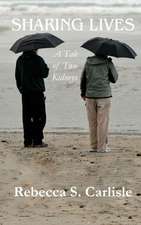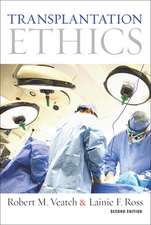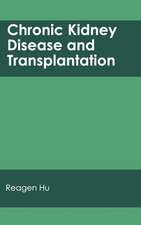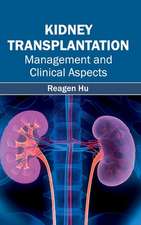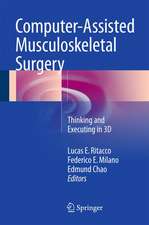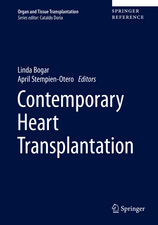Cardiac Allograft Rejection
Editat de G. William Dec, Jagat Narula, Manel Ballester, Ignasi Carrioen Limba Engleză Paperback – 23 oct 2012
This book by international experts in the fields of transplantation medicine, immunobiology and cardiac imaging provides the reader with an up-to-date, consise summary of the latest developments in the diagnosis and treatment of acute cardiac rejection. It is axiomatic that a more complete understanding of the pathogenic processes involved in rejection will ultimately lead to its prevention. This volume will be useful to transplant cardiologists, cardiovascular surgeons, cardiac pathologists and transplant scientists who seek to prolong the lifespan and improve the quality of life of their transplant recipients.
| Toate formatele și edițiile | Preț | Express |
|---|---|---|
| Paperback (1) | 1103.03 lei 6-8 săpt. | |
| Springer Us – 23 oct 2012 | 1103.03 lei 6-8 săpt. | |
| Hardback (1) | 1109.59 lei 6-8 săpt. | |
| Springer Us – 29 sep 2001 | 1109.59 lei 6-8 săpt. |
Preț: 1103.03 lei
Preț vechi: 1161.08 lei
-5% Nou
Puncte Express: 1655
Preț estimativ în valută:
211.06€ • 220.37$ • 174.68£
211.06€ • 220.37$ • 174.68£
Carte tipărită la comandă
Livrare economică 04-18 aprilie
Preluare comenzi: 021 569.72.76
Specificații
ISBN-13: 9781461356592
ISBN-10: 1461356598
Pagini: 456
Ilustrații: XVII, 434 p.
Dimensiuni: 155 x 235 x 24 mm
Greutate: 0.64 kg
Ediția:Softcover reprint of the original 1st ed. 2001
Editura: Springer Us
Colecția Springer
Locul publicării:New York, NY, United States
ISBN-10: 1461356598
Pagini: 456
Ilustrații: XVII, 434 p.
Dimensiuni: 155 x 235 x 24 mm
Greutate: 0.64 kg
Ediția:Softcover reprint of the original 1st ed. 2001
Editura: Springer Us
Colecția Springer
Locul publicării:New York, NY, United States
Public țintă
ResearchDescriere
Heart transplantation remains one of the major scientific achievements of twentieth century medicine. During the past four decades, it has evolved from an unproven experimental surgical technique to the most effective form of therapy for refractory end-stage heart disease. It has captured the public's imagination and expanded our understanding of fundamental immunologic mechanisms that are responsible for cellular and humorally-mediated immunity. Despite its successes, many clinical and scientific problems remain. One or more bouts of acute cellular or humoral (vascular) rejection will occur in over 75% of transplant recipients despite current immunosuppressive strategies. Further, rejection directly results in approximately 20% of post-transplant deaths and is believed to play a major role in the development of late allograft dysfunction and coronary vasculopathy.
This book by international experts in the fields of transplantation medicine, immunobiology and cardiac imaging provides the reader with an up-to-date, consise summary of the latest developments in the diagnosis and treatment of acute cardiac rejection. It is axiomatic that a more complete understanding of the pathogenic processes involved in rejection will ultimately lead to its prevention. This volume will be useful to transplant cardiologists, cardiovascular surgeons, cardiac pathologists and transplant scientists who seek to prolong the lifespan and improve the quality of life of their transplant recipients.
This book by international experts in the fields of transplantation medicine, immunobiology and cardiac imaging provides the reader with an up-to-date, consise summary of the latest developments in the diagnosis and treatment of acute cardiac rejection. It is axiomatic that a more complete understanding of the pathogenic processes involved in rejection will ultimately lead to its prevention. This volume will be useful to transplant cardiologists, cardiovascular surgeons, cardiac pathologists and transplant scientists who seek to prolong the lifespan and improve the quality of life of their transplant recipients.
Cuprins
Preface. Section I: Immunopathology of Cardiac Allograft Rejection. 1. Histocompatibility Antigens and Transplant Rejection; S. Pillai. 2. Cellular and Humoral Rejection after Cardiac Transplantation; M.L. Rose, et al. 3. Immunobiology of Chronic Cardiac Allograft Rejection; P. Koskinen, et al. 4. Inflammatory Cell Infiltration, Cytokines and Mechanisms of Myocyte Necrosis in Cardiac Transplant Rejection; J.B. Sundstrom, et al. 5. Apoptosis in Cardiac Transplant Rejection; M. Puig, et al. 6. Pathology of Cardiac Allograft Vascular (Microvascular) Rejection: Impact on Patient Outcomes; E.H. Hammond, et al. 7. Strategies for the Induction of Allograft Tolerance; T. Wekerle, et al. 8. Xenotransplantation: Hyperacute and Delayed Xenograft Rejection; K. Mawulawde, et al. Section II: Clinical Assessment and Management of Cardiac Allograft Rejection. 9. Endomyocardial Biopsy Diagnosis of Cardiac Allograft Rejection; B. Czerska, et al. 10. Clinical Diagnosis and Management of Cardiac Allograft Rejection and Maintenance Immunosuppression; T.G. Di Salvo, G.W. Dec. 11. New Immunosuppressive Agents; J.F. Gummert, et al. 12. Treatment of Acute Vascular Rejection in Cardiac Allografts; I.S. Wittstein, E.K. Kasper. Section III: Newer Diagnostic Tools for the Management of Cardiac Allograft Rejection. 13. Evolution of Noninvasive Testing for the Detection of Cardiac Allograft Rejection; R. Srivastava, J.D. Hosenpud. 14. Echocardiographic Diagnosis of Acute Allograft Rejection; N. Giannetti, H.A. Valantine. 15. The Use of Magnetic Resonance Imaging in Cardiac Transplantation Rejection; T.M. Koelling. Section IV: Radionuclide Imaging for Surveillance of Cardiac Allograft Rejection. 16. Targets for Radionuclide Imaging of Cardiac Allograft Rejection; H.W. Strauss. 17. Detection of Apoptosis for the Noninvasive Diagnosis of Cardiac Allograft Rejection; F.G. Blankenberg, et al. 18. Detection and Monitoring of Cardiac Allograft Rejection by Noninvasive Imaging of Lymphocyte Infiltration; K. Lin, J.J. Frost. 19. Detection of Cardiac Allograft Rejection by Targeting Expression of Accessory Molecules on Cardiac Myocytes; M. Isobe. 20. Algorithms for Management of Heart Transplant Rejection Based on Surveillance of Myocardial Damage by Antimyosin Antibody Imaging; M. Ballester, et al.




